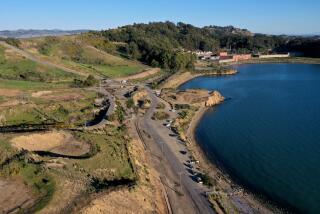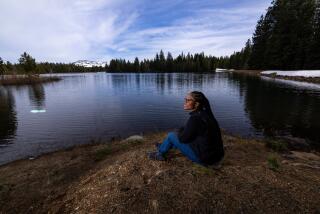Saving the Marsh
- Share via
Whitney Dotson was 5 years old when he moved into the brand-new house his father bought on Jenkins Way in Parchester Village. It was the early 1950s, and the planned 420-house development was Richmond’s first subdivision in which an African American could buy a home.
Nestled into a wide cove of San Francisco Bay, Parchester offered a welcome mix of open space, isolation and community, even though it was plopped down in an industrial landscape.
All the backyards on Jenkins Way--a long street with small, densely packed, flat-roofed homes--butt up against a 15-foot berm. On top of the berm, Southern Pacific freight cars hurl through space and shake the houses. Whitney’s mother, Mary Lee, who at 83 still lives in the neighborhood, kept her young kids away from the trains because everyone knew that a man named Jackson was killed on the tracks in Seaport, the community where they lived before coming to Parchester.
For three years, Whitney didn’t know what was on the other side of that berm. But at age 8, he and his brother Richard and a group of their friends got up the gumption to set out and explore.
“That’s when the Davy Crockett thing was happening,” recalls Whitney, who was one of many American boys to sport the raccoon-skin cap.
“They had to have the hat now,” says Mary Lee. “They’d be hollering, ‘Davy, Davy Crockett,’ marching up and down the street with them hats a-swingin.”
Their wilderness was no different from Davy’s--or so they imagined. They trekked north to explore the fringes of Giant Powder Co., the first corporation in America to produce dynamite.
They hiked east to Tank Farm Hill, where about 50 gas and oil tanks dominated the open grasslands like forts. They built a raft and, in ponds filled with shattered glass created by foundry waste, bravely fought off Indian pirates. And nothing could keep them from going across the tracks. But first, like Crockett, they put an ear to the rail to see if a locomotive was coming. A vibration against their ears meant “TRAIN!”
On the other side, Whitney and his friends discovered an expanse of richly textured marsh, green and lush in summer. Tidal sloughs snaked their cool, clear way out to the bay. Sea gulls, ospreys and avocets banked sharply in the marine air, and the pickleweed underfoot smelled awful. They didn’t know the names of the birds, nor did they have environmental classes to teach them why the water in the channels rose and fell.
Having never heard the word “marsh,” they just called it “over the tracks,” and in sun or fog they swam in the tidal channels and stomped through the glistening salt grass in the yellow boots that Mary Lee bought for them. They caught tadpoles in jars and watched them turn to frogs, running to their treasures first thing in the morning to see how the creatures had changed overnight.
Come early spring, Mary Lee would go to the fields surrounding the marsh to gather wild mustard and turnip greens. “They were nice and tender, because they were out there in the cold,” she says. “Oh, it was good, good. Everyone would come and eat. The menfolk would barbecue goat. Course I don’t like barbecue goat, but a lot of people do.”
Mary Lee grew up in Mossville, La., where the oak trees streamed with so much moss that the older generation dried it in the sun and stuffed it into mattresses and pillows. At 15, she married Richard Daniel Dotson, and in the mid-1940s they left the South for California with three children in tow and one on the way. (Whitney was their first California-born child.)
Like most of the other 500,000 African Americans who made the exodus to California between 1942 and 1945, it wasn’t merely the pull of employment that sent them on their way, but also the push of Jim Crow and racially motivated violence. “It was pretty treacherous around there for men,” Mary Lee says. “They didn’t have no good time in Louisiana, not the part we lived in.”
And so Parchester became a refuge. And within that refuge, the marsh became its own sanctuary--one of the last pockets of pristine tidal land along the bay.
Whitney’s father, the Rev. Richard Daniel Dotson, and other local ministers had tried to make sure that the area past the berm would be protected as open space. They had shaken hands on the deal with Fred Parr, a local white developer who had built Parchester after getting assurances from the ministers that their congregations would buy new homes there.
But in the decades to follow, the pressure to pave the area, known as Breuner Marsh, became unrelenting. In the mid-1970s, Whitney’s father and others successfully fought off a municipal airport intended for the marsh and launched a plan to transform the adjacent Giant Powder Co. property into a park. It is now the site of the Point Pinole Regional Shoreline.
More recently, developers have unfurled blueprints for several housing and light-industrial tracts in the marsh. The Parchester Village Neighborhood Council--where Whitney serves as president, just like his dad did--urged the East Bay Regional Park District to buy the land and add it to the Point Pinole Regional Shoreline. The developers declined the offer.
But in March, the neighborhood council got the word that it has been seeking for half a century: The park district board voted to acquire by eminent domain 218 of the 238 acres of the marsh.
Whitney is especially proud--and relieved. After living in Louisiana for 13 years, he had moved back to Parchester in 1996 to take care of his father, who died two years ago. A public health consultant with a master’s degree from UC Berkeley, he’s now helping to care for Mary Lee.
“My whole early life experience has been on the shoreline,” he says, his gaze turned toward a great blue heron’s stillness. “Everyone should have a place like this to go.”
Now it looks as if they’ll have the chance to.
More to Read
Sign up for The Wild
We’ll help you find the best places to hike, bike and run, as well as the perfect silent spots for meditation and yoga.
You may occasionally receive promotional content from the Los Angeles Times.






